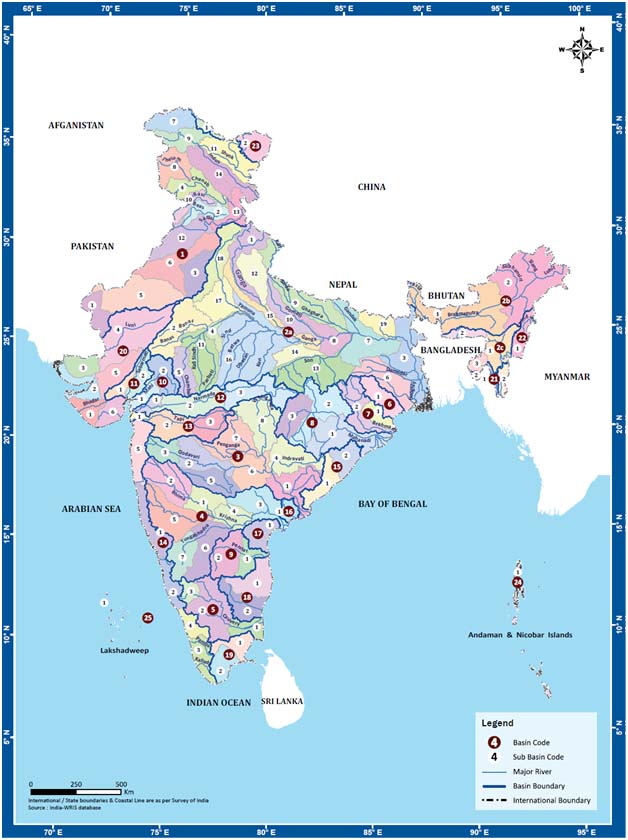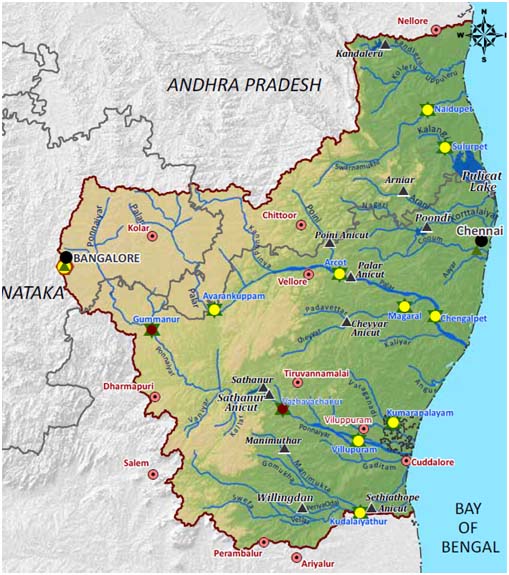This publication by the Central Water Commission (CWC) and Regional Remote Sensing Centre – West, Indian Space Research Organisation (ISRO) presents the status of water resources development in each of the river basins as per CWC classification. It was launched on November 1, 2012 by Minister of Water Resources Shri. Harish Rawat in a function organized at CWC, New Delhi.
This comprehensive publication gives detailed information of major water resources projects along with the location of all hydrological observation sites including major dams, barrages etc. in all the river basins of India.
This "River basin atlas of India", an outcome of joint project “Generation of Database and implementation of web enabled Water Resources Information System (India-WRIS) in the country”, is a publication by the Central Water Commission (CWC) and Regional Remote Sensing Centre – West, Indian Space Research Organisation (ISRO) that presents the status of water resources development in each of the river basins as per CWC classification. It was launched on November 1, 2012 by Minister of Water Resources Shri. Harish Rawat in a function organized at CWC, New Delhi.
This comprehensive publication gives detailed information of major water resources projects along with the location of all hydrological observation sites including major dams, barrages etc. in all the river basins of India. All these features have been portrayed on the maps with river network, major cities and terrain in background. The hydrological and Flood Forecasting observation sites of Central Water Commissions are also marked in the basin maps.

India-WRIS Sub-basins, Source: River basin atlas of India, CWC and ISRO, 2012
Attempts so far to delineate river basins in India
The first systematic attempt was in 1949 by the Central Water and Power Corporation (CWPC), wherein the entire country had been distinctly delineated into six water resources regions which had in turn been further divided into 66 major river catchments.
Subsequently, the Ministry of Agriculture, Government of India had assigned the work of preparation and codification of River Systems of India to a Consultant who in 1970 suggested / published the methodology based on the area concept. The suggested hydrological units were: water resource region, river basins, river sub-basin, watershed, sub watershed, mini-watershed and micro watershed. The recommended size of the watershed is from 250-750 sqkm.
A better working scale was achieved by the All India Soil and Land Use Survey (AISLUS) Organization of the Dept. of Agriculture and Cooperation which published the national level watershed atlas on 1: 1 million scale using the base map from Irrigation Atlas of India in the year 1990. In this atlas, the entire river systems of the country have been divided into 6 Water Resources Region, which has been further, divided into 35 basins and 112 catchments. These catchments have been further divided into 500 sub-catchments and 3237 watersheds. The atlas consists of 17 sheets on 1:1 million scales along with a Compendium of watersheds giving details of other related information such as area within the basin, sharing states and stream names etc.
Later, watershed maps at relatively larger scale (1:2,50,000) were prepared by Central Ground Water Board (CGWB) in 2006 using GIS techniques under Hydrology Project (Phase-I) wherein various thematic layers relevant to groundwater for integration in the dedicated software and consequently in the Hydrological Information System (HIS) developed in the project. Watershed was one of the layers envisaged for integration in the software to facilitate the groundwater assessment on watershed basis.
Water Resource Information System (WRIS) in India
The development of “Water Resources Information System” for the country is now being done by the Central Water Commission (CWC) and National Remote Sensing Centre (NRSC) of Indian Space Research Organization (ISRO). They have jointly conceptualized and are executing project India-WRIS WebGIS (www.india-wris.nrsc.gov.in) aimed as ‘single window’ solution of all water resources related data and information in a standardized GIS format.
Under the India-WRIS Project national level watershed atlas is being prepared on 1:50,000 scale. A semi-automated hydrological unit boundary delineation approach is adopted to prepare a Watershed Atlas of the Country using DEM, larger scale drainage network and other ancillary data.
Based on the requirements and data availability, the project scope envisages 12 major info systems, 35 sub info systems with 108 spatial layers including 20 base layers, classified under 5 major groups along with the report generation. These spatial layers have large number of attribute data of 5-100 years depending upon the theme. The project envisages WGS-84 datum and LCC projection for entire country mosaic data as followed in ISRO under the national projects/missions.

East flowing rivers between Pennar and Kanyakumari, Source: River basin atlas of India, CWC and ISRO, 2012
The project involved installation of ‘Web Enabled Water Resources Information System (India-WRIS)’ with all database and development of software with following tools - Data visualization tools, Query and discovery tools, Contextual tools, Visual analysis tools, Metadata & information tools and Reporting tools. India-WRIS WebGIS Version 2.0 was launched in March 2012. All the information on water resources projects, hydrology and other related data of India as received from CWC and various state departments till November 2011 were organized as a part of the database.
The present information system has large number of GIS layers for various components of surface water, ground water, hydro met observations, water quality, snow cover, inland navigation waterways, inter-basin transfer links, hydro met extremes, land resources, water tourism, socio-economic parameters as well as infrastructure and other administrative layers. India-WRIS WebGIS (version 3.0) has all the basic map viewing and other capabilities including saving/printing facilities.
Numerous categories of tools are available namely, Navigation (Zoom In, Zoom Out, Pan, Full Extent, Previous Extent, Next Extent, Map Overview, Go To and Select Area Zoom/Rubber Zoom), Display (Swipe, Spotlight, Visualization, Magnifier, Get Feature Info and Identify), Search & Query (Query Builder and Search by Proximity), Personalization (Draw, Print, Save as Image, Bookmark and Pin Mark) and Sharing (Share a Link, iFrame and Links on twitter/Facebook/Google+). These are useful for easy search, access, visualize and analysis of information.
"River Basin Atlas of India" as one of the outcomes under India-WRIS project
River basins are ideal units for planning and implementation of water resources projects. The basin maps provided in the atlas are as per CWC basin classification. The maps are given with DEM and hillshade of the country as the background so as to provide topographical details. A total of 22 river basin maps/plates of 20 CWC basins have been generated indicating major dams, hydrological observation sites of CWC and major cities. The drainage network shows all major rivers and important tributaries.
To impart the geographical land use of the basin, land use/land cover map (2005-2006) is also given. Elevation zone and average annual rainfall maps with statistics are also provided. The parliamentary constituencies are also displayed within the river basin boundary.
According to S P Kakran, Chairman, Central Water Commission “this atlas shall be a very useful reference for diverse users, like, Ministry of Water Resources, Agriculture, Rural development etc. of union government and various line departments of state governments and several non-governmental organizations, research institutes involved in natural resources management in the country".
The report is divided into three main parts –
Introduction – This begins with an account of the State-wise Area, Population, Population Growth and Parliamentary Constituencies. The population growth for the period (2001-2011) is depicted. Land use and land cover map for the year 2005-2006 is provided. Average annual and monthly rainfall is presented for the period 1971-2005. Also shown are Water resource divisions/ regions, hydrology of Indian region, CWC Basins & India-WRIS Basins and Sub-basins, Flood Forecasting Stations in India, Water Resource Projects of India.
River Basins of India – The river system in India is classified into four groups - Himalayan Rivers, Deccan Rivers, Coastal Rivers and River of Inland Drainage. It has been divided into twelve major basins and eight composite basins. These twenty basins are shown in the River Basin Atlas of India.
India-WRIS Project: Digital Watershed Atlas - This section provides an account of the project.
The drainage network shows all major rivers and important tributaries. State wise distribution of basin area is also represented through pie charts. The culturable command area and ultimate irrigation potential of major irrigation projects in each basin is tabulated. Salient features of the basin like live storage capacity, catchment area and average water resource potential are also given in tabular form. In the Hydrology of Indian Region map, trans-boundary water inflow and out flow of the country is depicted for Indus, Ganga, Brahmaputra and Barak basins.
An explanatory line diagram is given for each basin showing the course of the major river from its origin to outfall and its tributaries along with headworks and photographs of water resource structures.

Flow diagram of Cauvery river, Source: River basin atlas of India, CWC and ISRO, 2012
Apart from this, thirteen country level maps of Administrative Boundaries, Population Growth, Parliamentary Constituencies, Water Resources Division, Water Resources Region, Hydrology of Indian Region, CWC Basins, India-WRIS Basins, India-WRIS Sub-Basins, Flood Forecasting Stations, Land use / Land cover, Average annual and monthly rainfall are also provided for complete insight of water scenario in the country.